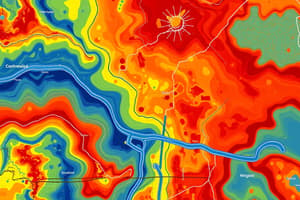Podcast
Questions and Answers
Climatologists study weather conditions over extended ______, often characterized by mean temperatures, precipitation levels, humidity rates, seasonality, wind patterns, atmospheric pressures, and other aspects of the natural environment.
Climatologists study weather conditions over extended ______, often characterized by mean temperatures, precipitation levels, humidity rates, seasonality, wind patterns, atmospheric pressures, and other aspects of the natural environment.
periods
From satellite images revealing global temperature changes and shifting migration routes due to altering climatic zones, to the examination of ______ within small geographical areas such as gardens and shaded backyard corners, climatology permeates every aspect of our planet's surface.
From satellite images revealing global temperature changes and shifting migration routes due to altering climatic zones, to the examination of ______ within small geographical areas such as gardens and shaded backyard corners, climatology permeates every aspect of our planet's surface.
microclimates
This field has grown exponentially since its earliest beginnings when sailors observed patterns in ocean winds and cloud formations during long voyages across vast ______.
This field has grown exponentially since its earliest beginnings when sailors observed patterns in ocean winds and cloud formations during long voyages across vast ______.
oceans
Climatology serves as a crucial component of our understanding of ______.
Climatology serves as a crucial component of our understanding of ______.
Climatology encompasses everything from the large-scale processes driving hurricane formations to minute details like soil moisture variations affecting plant ______.
Climatology encompasses everything from the large-scale processes driving hurricane formations to minute details like soil moisture variations affecting plant ______.
Exploring Climatology within the Field of Geography helps us understand the intricate relationship between climates and ______ landscapes.
Exploring Climatology within the Field of Geography helps us understand the intricate relationship between climates and ______ landscapes.
These elements collectively shape the behavior of ecosystems through complex interactions that ultimately influence human societies in ______ ways.
These elements collectively shape the behavior of ecosystems through complex interactions that ultimately influence human societies in ______ ways.
Climatology studies mean temperatures, precipitation levels, humidity rates, seasonality, wind patterns, atmospheric pressures, and other aspects of the ______ environment.
Climatology studies mean temperatures, precipitation levels, humidity rates, seasonality, wind patterns, atmospheric pressures, and other aspects of the ______ environment.
Sailors observed patterns in ocean winds and cloud formations during long voyages across vast ______.
Sailors observed patterns in ocean winds and cloud formations during long voyages across vast ______.
Climatology permeates every aspect of our planet's surface, from global temperature changes to the examination of ______ in small geographical areas.
Climatology permeates every aspect of our planet's surface, from global temperature changes to the examination of ______ in small geographical areas.
Flashcards are hidden until you start studying
Study Notes
Exploring Climatology within the Field of Geography
To understand the intricate relationship between climates and physical landscapes, we delve into the realm of climatology, which serves as a crucial component of our understanding of geography. Climatologists study weather conditions over extended periods, often characterized by mean temperatures, precipitation levels, humidity rates, seasonality, wind patterns, atmospheric pressures, and other aspects of the natural environment. These elements collectively shape the behavior of ecosystems through complex interactions that ultimately influence human societies in profound ways.
From satellite images revealing global temperature changes and shifting migration routes due to altering climatic zones, to the examination of microclimates within small geographical areas such as gardens and shaded backyard corners, climatology permeates every aspect of our planet's surface. It encompasses everything from the large-scale processes driving hurricane formations to minute details like soil moisture variations affecting plant growth.
This field has grown exponentially since its earliest beginnings when sailors observed patterns in ocean winds and cloud formations during long voyages across vast oceans. Today, advanced technologies enable scientists to monitor environments across multiple scales—from local regions experiencing dramatic shifts caused by phenomena like El Niño events to macroscopic rearrangements brought about by climate change affecting entire continental masses.
As humans continue to grapple with pressing concerns related to global warming, water scarcity, air quality degradation, extreme weather events, and the preservation of habitats and wildlife species adapted to specific climate regimes, climatology plays a vital role in predictive modeling and policy decisions regarding resource management, disaster preparedness, and conservation efforts worldwide.
Studying That Suits You
Use AI to generate personalized quizzes and flashcards to suit your learning preferences.




